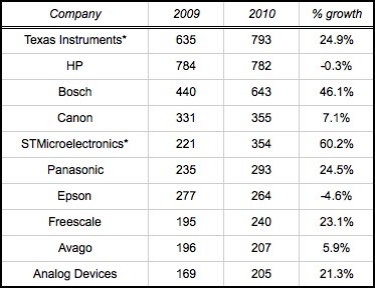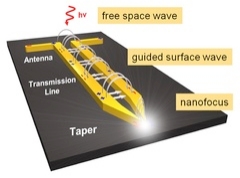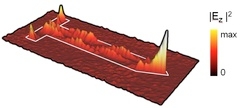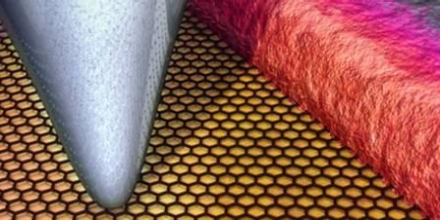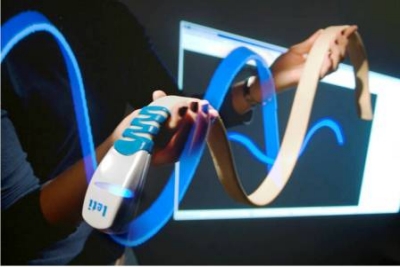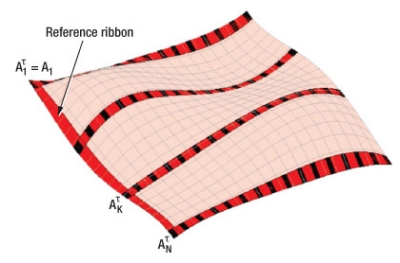April 4, 2011 — Yole Développement released a report on ferroelectric thin films, comprising an overview of the ferroelectric thin films applications and the current and future industrial ferroelectric thin films users in each application. Yole analyzes deposition techniques and materials (PVD, CVD, CSD) trends, and shares production data for ferroelectric thin films (ferroelectric thin film production forecast 2010-2015 in number of wafers, market shares of the different detection techniques globally and by application, market shares of the ferroelectric material).
Ferroelectric thin films have been used for many years in integrated passives devices (IPDs), ferroelectric memories (FeRAM) and MEMS inkjet heads. Such thin films can be used for ferroelectric, piezoelectric or pyroelectric properties.
Ferroelectric materials were considered exotic semiconductor materials in the past. Thanks to better knowledge and industrialization of these materials, they are increasingly used in many new applications, especially in the MEMS field: MEMS wafer-level autofocus, RF MEMS, MEMS ultrasonic transducers infrared sensors, IPD tunable capacitors, and many others.
 |
| Figure. Ferroelectric thin films market forecast (in K wafers 6" eq). SOURCE: Ferroelectric Thin Films Report, Yole Développement. |
Physical vapor deposition (PVD) is the dominant deposition technique but chemical solution deposition (CSD) techniques will increase its market share greatly, especially in MEMS applications, thanks to its better material composition. PZT, the most well-known ferroelectric material, will keep the leadership on SBT, BST, except if other materials are developed to replace lead, blacklisted by the RoHs European directive.
Driven by existing and new applications, the production of ferroelectric thin films will grow from 881,000 6" eq. wafers in 2010 to 1,263,000 wafers in 2015, meaning a CAGR of +7.5 %. Inkjet head application and IPDs ESD/EMI planar capacitor represent more than 90% of the production in 2010 but other applications will grow strongly to reach globally 26% of the total production in 2015.
Large industrial companies are already using ferroelectric thin films in various applications fields, showing the reliability of this technology:
- IPDs: NXP, STM
- MEMS: EPSON
- FeRAM: Panasonic, Fujitsu, Rhom, Oki, Ramtron
|
Companies cited in the report:
Argonne lab, Asicon, Avx, BAE, Brother, CEA Le Ripault, Cranfield University, Deplhi, DRS, Epcos, EPFL, Epichem, Epiphotonics, EPSON , FLIR, Fraunhofer IMT, Fraunhofer IPMS, Fujifilm Dimatix, Fujitsu, Gennum, Hammamatsu, Heimann, Holst centre, Hynix, IBM, Imagine Optic, IMEC, Infineon, Inostek, Ipdia, Irisys, KIST, Kojundo lab, Korean Institute of Technology, KTH, L3Com, LAAS, Lemoptix, Lensvector, LG , Matsushita, Maxim, Microsystem lab, Microvision, Mitsubishi Chemical, Murata, Nippon Ceramic, NovioMEMS, NovioMEMS, NXP, Oce, Oerlikon, OKI, Olympus, ON semiconductor, Onchip, Panasonic, Panasonic, Paratek, Philips, Philips Research, Polight, Pondus Instruments, Pulse, Pyreos, Pyreos, Ramtron, Rohm, Samco, Samsung, Semtech, Siemens Medical, Singapore univ, Sintef, Solmates, Sonitor, Sound Design Technology, Steinbeis Transfer centre, ST microelectronics, Suss, Symetrix Corporation, Tango, Technolas perfect vision, Tegal, Texas Instrument, Tezzaron, Thales, Toshiba, Tyndall, Ulis, Ulvac, US Army lab, Vermon, VTT, Western digital, Wispry, Xaar.
|
In the next 5 years, many new players plan to adopt or evaluate ferroelectric thin films to enter on key markets, from SMEs (Polight, Irisys, NovioMEMS, etc.) to large groups (Océ, Xaar, Delphi, IBM, Philips research, etc).
Ferroelectric Thin Films report from Yole gives an overview of the ferroelectric thin films industry today. It helps devices manufacturers to evaluate the benefits of using ferroelectric think films technologies, identify new business opportunities and partners, monitor their competitor’s advancements. It also helps materials manufacturers, investors, R&D centers and MEMS & Packaging foundries in their developments to identify new opportunities and partners.
Authors:
Yann de Charentenay was granted a master degree in physics in INPG in Grenoble and also in Innovation management from Compiegne University. Since 2003, he has worked for Yole Development in the field of MEMS, materials and compound semiconductors. He has contributed to more than 50 marketing and technological analysis.
Dr. Eric Mounier has a PhD in microelectronics from the INPG in Grenoble. Since 1998 he is a cofounder of Yole Developpement, a market research company based in France. At Yole Developpement, Dr. Eric Mounier is in charge of market analysis for MEMS, equipment & material. He is Chief Editor of Micronews, and MEMS’Trends magazines (Magazine on MEMS Technologies & Markets).
Yole Développement is a group of companies providing market research, technology analysis, strategy consulting, media in addition to finance services. More information on www.yole.fr.
Follow Small Times on Twitter.com by clicking www.twitter.com/smalltimes. Or join our Facebook group


